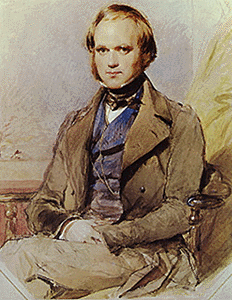A nineteenth-century Englishman, Charles Darwin shown at left, was the first to present a coherent scientific theory of how species had changed over time. By Darwin’s time, accumulating fossil evidence, selective breeding of livestock, pets, and other animals, along with many other lines of evidence, strongly suggested that species were not fixed and immutable as previously assumed, but were capable of transformation into new forms. The question was: how? What was the process by which modification of species came about? Most of the support for the idea that species were immutable was grounded in theology, but there were also scientific objections — or unanswered questions — that Darwin had to address.
Darwin’s famous book, On the Origins of Species by Means of Natural Selection, published in 1859, advanced the theory that species came into existence by gradual changes over a long period of time. To explain the process, Darwin postulated two basic processes continually at work in nature. The first, "variation," continually occurs within species and can be observed. That is, individual offspring of the same species — indeed, of the same parents — vary slightly from one another. Members of the same litter of pups or the thousands of offspring of a pair of salmon are not identical to each other or to their parents. Darwin was not certain why variation occurred; he only observed that it, in fact, happened that way.
Darwin noted further, that because of their different characteristics, individual offspring were not equally successful in the struggle to survive and reproduce. He called this weeding out process with consequent differences in reproductive success "natural selection" — which is the second of his two natural processes.
Darwin concluded that individuals whose characteristics fitted them to the circumstances in which they found themselves would have more offspring than less suitably adapted individuals. Over time, the characteristics that gave the former a reproductive advantage would become more fully expressed in their descendants. Given enough time, these small accumulating changes would result in a new species. Darwin’s theory is, in essence, very simple: new species have emerged on earth from earlier life forms because of the operation of variation and natural selection.
Darwin’s theory organized the vast amount of biological data collected by generations of naturalists up until his times, including the huge and rapidly increasing fund of knowledge of extinct forms of life from fossils. By Darwin’s time, the process of classifying the world's flora and fauna had achieved some depth and maturity. If you imagine the taxonomists’ early attempts to draw “family trees” for life forms, particularly the group called “vertebrates,” it is easy to see how Darwin's theory added a dimension of time to the "family tree" of earth's life forms. For example, cat-like or dog-like creatures could not only be grouped together in an appropriate “family” based on anatomical similarities, but one could trace the descent and development of both families and individual species in the fossil record. Thus, the theory not only confirmed relationships among existing families of plants and animals, but also threw light on the relationships of living species to extinct life forms.


